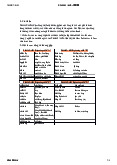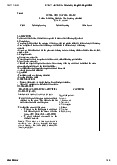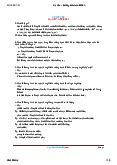




Preview text:
20:29 29/7/24 RTN3 UNIT 5 Euro Dol ar TB UNIT 5 MONETARY POLICIES
The Euro is Equal to the Dollar. Here’s Why It Matters. PRE-READING TASKS 1. 1. 1-d 2-f 3-e 4-b 5-g 6-a 7-c
2. Watch the video: https://www.youtube.com/watch?v=nkuaXOWCrBs
A depreciation of the value of the exchange rate happens in a floating currency system
(unintentionally) whereas a devaluation happens inside a fixed or semi-fixed exchange rate system (deliberately) Further reading about Fed and rate hikes:
https://www.atfx.com/vi/analysis/trading-strategies/how-fed-rate-hikes-affect-stock-forex-market
READING FOCUS: USING TERMINOLOGIES
Find technical words/terms of economics in the article The Euro Is Equal to the Dollar.
Here’s Why It Matters (in addition to the listed ones in the Pre-Reading section) and discuss
their meanings with your partner(s). -
Exchange rate (noun) the rate at which one currency will be exchanged for another currency. -
Parity (noun) (P. 1) a situation where one unit of a currency has exactly the same value as one unit of another currency -
Commodities (P. 2) a basic good used in commerce that is interchangeable with other
goods of the same type. Commodities are most often used as inputs in the production of
other goods or services. A commodity thus usually refers to a raw material used to
manufacture finished goods. A product, on the other hand, is the finished goods sold to consumers. -
Recession (P. 2) a difficult time for a country’s economy, with less trade and industrial
activity and a high rate of unemployment about:blank 1/5 20:29 29/7/24 RTN3 UNIT 5 Euro Dol ar TB -
Interest rate (P. 4) the percentage amount that you pay for borrowing money (borrowing
interest rate), or get for lending money (lending interest rate) for a period of time - Yield (P. 4) profit -
Treasury bond (P. 4) on US government bonds/debt securities issued by the U.S. Federal
government with a fixed rate of interest) - Greenback (P. 4) a USD note -
Market reassurances (P. 8) financial or monetary policies/measures said or done to stabilize the markets -
Depreciation (P. 8) the amount by which a currency loses value in comparison with other currencies -
Flows (P. 9) the ways money and credits circulate in the economy -
Liquidity (P. 9) being available in the form of money or of being able to be changed into money easily -
Risk profile (P. 9) the amount of risk involved in an investment -
Shifting global currencies (P. 10) changing the rank/value among important money/media
of exchange from multiple countries -
Currency translations (P. 13) the activity of giving the value of an amount in one
currency in a different currency -
Repatriated profits (P. 13) the profits sent back to one’s home country -
Price indices (P. 14) plural form of price index - measure of relative price changes,
consisting of a series of numbers arranged so that a comparison between the values for
any two periods or places will show the average change in prices between periods or the
average difference in prices between places. -
Deciphering prices (P. 15) converting prices in one currency into another currency
UNDERSTANDING THE ARTICLE
1. Words and phrases explanation:
Explain the following words and expressions, as used in the article. a.
in its infancy (P. 1): during the early development of the euro b.
wean itself off (P. 3): (the EU) gradually stops using Russian oil about:blank 2/5 20:29 29/7/24 RTN3 UNIT 5 Euro Dol ar TB c.
pushing yields on Treasury bonds higher (P. 4): (higher interest rates have resulted in)
increasing profits on US government debt securities d.
penciled in (P. 5): wrote down something in pencil that you know might have to be
changed later => the ECB has arranged for an increase in interest rate ( a rate hike) to
happen in July, being totally aware that this arrangement might be changed e.
have a straight line to consumers (P. 8): the product (grain) sold directly to the customers f.
currency translations on repatriated profits (p. 11): the profits (made by US multinational
companies) in foreign countries when being changed/returned into US dollar (will be
lessened as US dollar value is too high) g.
deciphering prices (P. 13): converting prices in one currency into another currency =>
converting prices in US dollar into euro and vice versa
2. Comprehensive questions
Read the article and answer the following questions in your own words. a.
Why is the euro falling against the dollar?
There are many reasons for the euro’s reduced value. The major cause lies in the conflict
between Russia and Ukraine, which has negatively affected many countries in Europe depending
on Russian fossil fuel (P. 3). Meanwhile, interest rates on the dollar have been raised by the Fed
(several times at a higher rate and faster pace than the rates on the euro by the European Central
Bank) in an attempt to control inflation, making the dollar a better choice for investors compared to the euro (P. 4-5). b.
How have experts evaluated the situation and investment prospects of the two currencies at this time?
Given the depreciation of the euro and the instability of Europe’s economy, the dollar is expected
to gain popularity as a more attractive currency for investment than the euro (P. 4).
c. What did EU and US do to control the inflation? Who adopted stronger measures?
They both increase the interest rates. US adopted stronger measures as they raised rate by 0.75
percentage point while EU expected a 0.25 percentage point rate hike. (P. 4-5) about:blank 3/5 20:29 29/7/24 RTN3 UNIT 5 Euro Dol ar TB d.
In export and import businesses, who are the winners and losers? Why?
In the EU: winners are exporters selling wares as the weaker euro makes their exports more
attractive in terms of price; while losers are importers of raw materials as they will become more expensive. (P. 8-10)
In the US: winners are commodities buyers as the strong dollar can drive global commodities’
prices lower; while losers are American exporters (as foreign buyers’ purchasing power is
weakened) and US multinational companies (as their profits made oversea in other currencies
when being changed into US dollar are also being affected). (P. 11-12)
e. How do American people benefit from the stronger dollar?
The stronger dollar will benefit American visitors while travelling both inside and outside euro
zone, giving them greater spending power when the dollar is going up against other currencies as well. (P. 13) SUMMARY
Summarize the main ideas of the last two paragraphs (from “Commodities such as grain…”
to the end) into 3-4 sentences (50-60 words)
The recent parity of the euro and dollar has presented enterprises and purchasers in the Eurozone
and in the US with both opportunities and challenges. Some people believe that with euro being
equal to dollar, the hike in prices of commodities which are usually stick to the dollar will slow
down. Regarding to benefit for individuals, US citizens may gain an advantage when visiting
European destinations whereas the opposite will happen to those dwelling in Europe on their trips abroad. TRANSLATION
Translate the last two paragraphs into Vietnamese, from “Commodities such as grain…” to the end. about:blank 4/5 20:29 29/7/24 RTN3 UNIT 5 Euro Dol ar TB
14. Theo ông Jay Hatfield, giám đốc điều hành tại Infrastructure Capital Management (Công ty
Quản lý Vốn Cơ sở hạ tầng), các hàng hóa cơ bản như ngũ cốc và kim loại công nghiệp gần đây
đã trở nên đắt hơn, nhưng đồng đô la mạnh hơn có thể giúp kiềm chế/kiểm soát giá cả. Hôm thứ
Ba trong một ghi chú, ông Hatfielf cho biết: “Đồng đô la mạnh khiến giá các hàng hóa cơ bản
toàn cầu thấp hơn, vì hầu hết hàng hóa cơ bản đều được định giá bằng đô la Mỹ. Chúng tôi dự
đoán rằng lạm phát sẽ bắt đầu giảm đáng kể vào mùa thu khi giá hàng hóa được phản ánh trong các chỉ số giá cả."
15. Sự tụt giá của đồng euro xuống bằng đồng đô la Mỹ khiến việc tiêu dùng trở nên đắt đỏ hơn
với người dân châu Âu hay những người nhận lương bằng đồng euro mà đi du lịch hoặc tiêu pha
bằng đồng đô la Mỹ. Đối với những người Mỹ coi châu Âu là điểm đến du lịch yêu thích/thường
xuyên, tỷ giá trao đổi ngoại tệ gần 1-1 đồng nghĩa với việc họ vừa có thể đổi ngoại tệ nhanh
chóng dễ dàng hơn, vừa có sức mua sắm/tiêu dùng mạnh hơn khi thăm quan các điểm đến thuộc
khu vực đồng euro như Pháp, Đức, Tây Ban Nha, Ý và Hy Lạp. Biến động của thị trường tiền tệ
cũng có thể mang lại lợi ích cho những người Mỹ đi du lịch bên ngoài khu vực đồng euro. Trong
tháng vừa qua, đồng đô la Mỹ cũng đang tăng giá so với đồng peso của Mexico, đô la Canada và
đô la Úc, và đồng won của Hàn Quốc. about:blank 5/5




